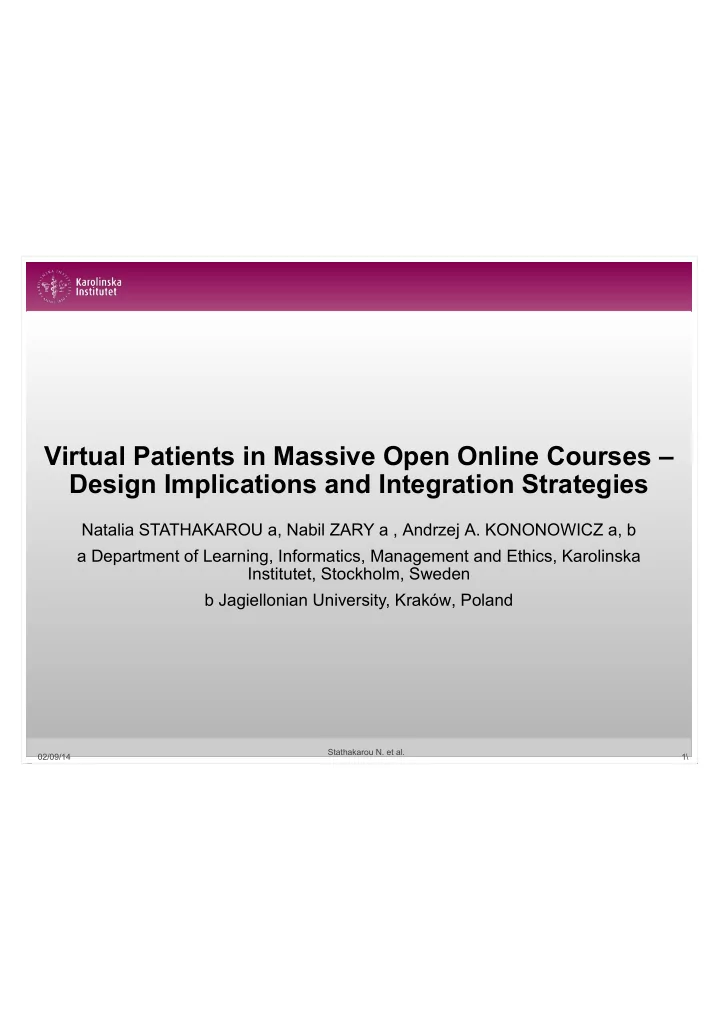

Virtual Patients in Massive Open Online Courses – Design Implications and Integration Strategies Natalia STATHAKAROU a, Nabil ZARY a , Andrzej A. KONONOWICZ a, b a Department of Learning, Informatics, Management and Ethics, Karolinska Institutet, Stockholm, Sweden b Jagiellonian University, Kraków, Poland Stathakarou N. et al. 02/09/14 1\
Massive Open Online courses (MOOCS) ● Recent trend in education ● Open access to universities’ courses ● Karolinska Institutet: ● EdX initiative ● Behavioral Medicine MOOC ● Criticism on MOOCs’ pedagogical models Stathakarou N. et al. 02/09/14 2
MOOCs for clinical reasoning skills training? ● Extending MOOCs with Virtual Patients (VPs) ● VPs have potential features to address some of the MOOCs’ problems Stathakarou N. et al. 02/09/14 3
Research Questions ● How can VP features leverage MOOC possibilities? ● What are the technical requirements for implementing VPs in MOOCs? Stathakarou N. et al. 02/09/14 4
Exploring scenarios for use of VP features in MOOCs ● MOOC possibilities: Distributed nature of intelligence, Mass customization Grover S, Franz P, Schneider E, Pea R. The MOOC as distributed intelligence: dimensions of a framework & evaluation of MOOCs, Proceedings CSCL 2013, vol. 2; Madison, USA, 2011, 42–45. Stathakarou N. et al. 02/09/14 5
Exploring scenarios for use of VP features in MOOCs ● Thematic literature review of VP features ● Scenarios for utilizing the explored VP features in MOOCs Stathakarou N. et al. 02/09/14 6
Scenarios for using VP features in MOOCs ● Use Case A : Collective evaluation of decision making in the context of uncertainty ● Provide audience VP cases containing ill-defined clinical problems ● Collect responses in Script Concordance Test (SCT) format. Stathakarou N. et al. 02/09/14 7
Scenarios for using VP features in MOOCs The SCT format: ● A hypothesis is generated ● New information is provided ● Evaluating the impact of the new information on the initial hypothesis Lubarsky S. Acad. Med. Vol. 89, No. 7, Jul 2014 Stathakarou N. et al. 02/09/14 8
Scenarios for using VP features in MOOCs ● Use Case B : Collective repurposing of cases and division of discussion into subgroups focusing on local variances in healthcare ● The discussion board is divided in national/ regional level ● Discussion for repurposing VP cases Example of VP case from eViP repository, modified http://www.virtualpatients.eu Stathakarou N. et al. 02/09/14 9
Scenarios for using VP features in MOOCs ● Use Case C : Division of content into short cases for flexible selection and adaptive learning with VPs: ● Large collection of short VP cases ● Integrated VP cases with computational models Kononowicz AA et al, A framework for different levels of integration of computational models into web-based virtual patients. J Med Internet Res. 2014 Jan 23;16(1):e23. doi: 10.2196/jmir.2593. Stathakarou N .et al. 02/09/14 10
Investigation of technical requirements ● Variant of Activity Theory’s framework by Wilson Stathakarou N. et al. 02/09/14 11
Technical requirements Stathakarou N. et al. 02/09/14 12
Technical requirements Interaction Required Tool Approach • Learner A – Learner B • Identity management • IMS LTI mechanism standard • Learner – VP content • Personalized access to • Healthcare content LOM standard • Filtration and prioritization of • Competency the VP cases assessment tool • Learner – Delegated • Self-formation of a hierarchy • Karma Point roles mechanism • Learner – MOOC • Forking of the case into local • Wiki – like community in parallel-edited adaptations mechanism • Learner – Credentials • Documentation of • Digital achievement of the planned Badges learning objectives Stathakarou N. et al. 02/09/14 13
Stathakarou N. et al. 02/09/14 14
Summary ● Extending MOOCs with VPs for clinical reasoning skills training ● Three use cases utilizing VP features to leverage MOOC approaches ● Technical requirements for implementing the use cases ● Future studies: Practical usefulness of the use cases Stathakarou N. et al. 02/09/14 15
Thank you for your attention! Stathakarou N. et al. 02/09/14 16
Why Activity Theory? ● Already applied before in the analysis of VP activities ● Emphasizes that all education can be to some extent technology-mediated, rather than distinguishing e- learning interventions (such as VPs) from other forms of learning ● Analyzing participants’ activity in context of community ● By the use of Wilson’s framework the tools needed to enable interactions between the elements of the information system were identified in a systematic manner Stathakarou N. et al. 02/09/2014 17
Recommend
More recommend